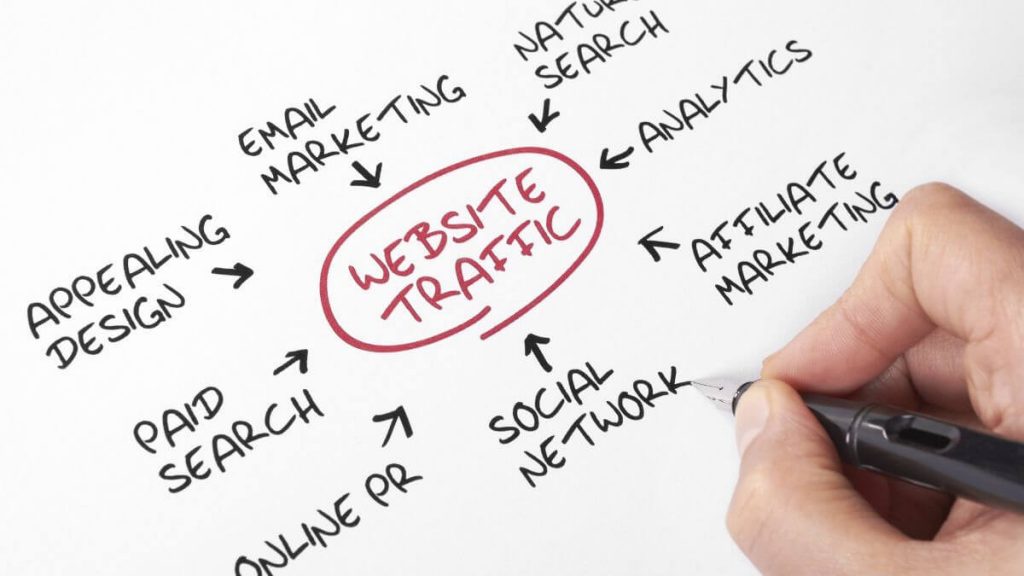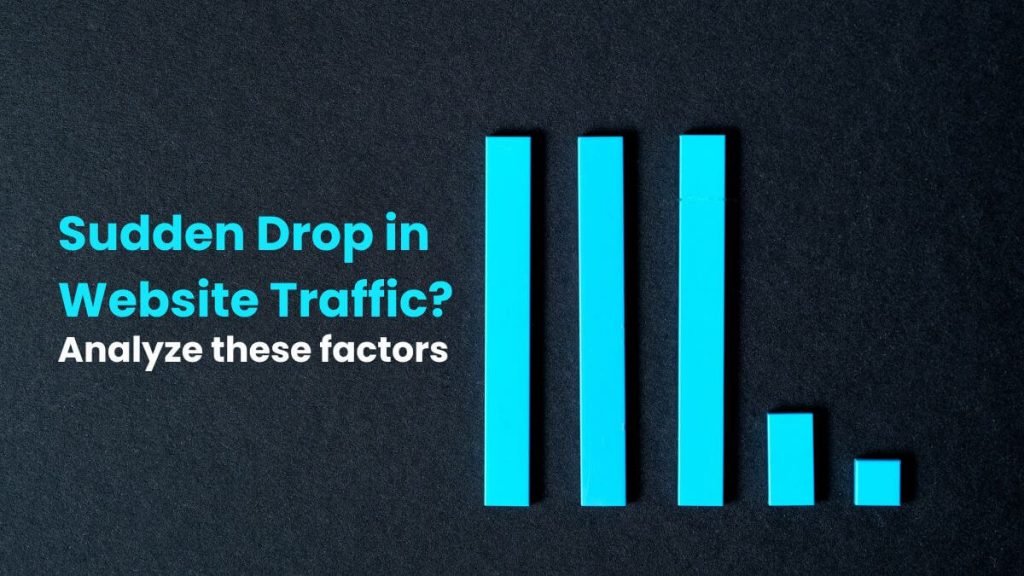The most terrifying thing for a Digital Marketer or a Digital Marketing Agency is “A Sudden Drop in Website Traffic.” This is nothing less than a nightmare for any service-providing agency. We all know websites exist to be visited, yet different sites have varied definitions of visits.
Some sites may not be selling anything, or they may be selling a brand, in which case simply getting people to look at your material counts as a gain. Whatever your website is about, traffic equals customers. In search engine jargon, ranking equals traffic, which equals consumers. So it’s an issue if your search ranking – or your traffic – declines.
It could be your obligation to research the problem and work out how to get things back on track, whether you’re a digital marketer, SEO expert, webmaster, or another stakeholder.
Today, the recent search algorithm update is the most prevalent reason for a sudden drop in website traffic. Other acceptable reasons for declining a sudden drop in website traffic include penalties, redirection, erroneous robots.txt regulations, and ranking losses.
The following questions would help you understand the sudden drop in website traffic:
- Is it a gradual drop or a sudden drop in website traffic?
- Is the webpage decline a consistent trend that has lasted more than a month?
- Was it a one-time blip or a seasonal dip?
- Does it appear that the decline in website traffic is self-correcting?
- What traffic metrics aren’t Working?
So, what comes as your responsibility to analyze and rectify this sudden drop in traffic? What factors should you diagnose and correct?
Algorithm updates
Google is constantly tweaking its algorithms to better its methods and outcomes. Many websites have been harmed due to these adjustments, and their rankings have plummeted as a result.
Use a successful cross-channel marketing and traffic strategy that combines social media and other marketing channels to avoid a sudden drop in website traffic.
Improved Competitors
It’s possible that despite doing everything correctly, you’re losing visitors and seeing a drop in your ranks. One cause for this could be that your competitors are outperforming you.
Analyze and monitor your competitors’ social media activity, link-building techniques, and content marketing to keep an eye on them. To check what modifications your competitors have made, utilize tools like Versionista.
You may also use backlink tools to discover whether they’ve received any new backlinks; they could be doing their SEO campaign.
Make some of the same changes your competitors did to outrank you once you’ve figured out what they did.
Slow Page Loading
The speed with which the material on your pages loads impacts your rankings and the user experience.
Bounce rates are higher when pages take longer to load because consumers don’t want to wait to read your content. Depending on how quickly the page loads, it is ranked as fast, sluggish, or average. This can over time reduce your website traffic due to bad user experience.
Server Side Issues
A malfunctioning caching function or empty markup served to Googlebot could be the cause of server troubles on your site.
Any server difficulties must be resolved as soon as possible. Examine your server logs for issues, and utilize Google’s Fetch and Render tool to see how a URL on your site is rendered and crawled. A sudden drop in website traffic due to non-responsive pages is a likely factor.
Internal Linking Structure
Your website navigation tells your visitors what information they can find on your site and where they can find it. For interior navigation, aim for a flat, narrow structure with two or three floors at most.
Visitors are more likely to depart if they have to click too many times to find what they’re looking for. Search engines may stop crawling content that is hidden deep within your website. As a result, your ranks will drop, and traffic to crucial content areas will decrease.
Internal link techniques are essential to your other client retention strategies, as well as solid search optimization.
Internal linking and straightforward and logical navigation promote customer retention and other ranking criteria such as time-on-site.
Keyword-rich internal links will aid search engines in determining what your site is about and whether your content is relevant to inquiries.
Technical SEO Factors
The health of your website’s technical base is measured by technical SEO. Its SEO effort has an impact on how search engines crawl and index your content. See how serious are the most common mistakes in SEO.
Addressing some of the most prevalent issues that may impact your website’s traffic and rankings Knowing about technical SEO difficulties might help you take better care of your website and maintain its ranks.
Wayward or Incorrect Meta Information
Metadata, often known as meta tags, are used to educate search engines about the content of your website. The title tag is one of the primary forms of metadata that can help you improve your SEO rankings. Headers and meta descriptions are two other sorts of metadata that might help your website rank higher.
You will not only confuse your consumers if you use the same title for many pages, but you will also be competing with yourself in the SERPs. When it comes to supplying meta information, don’t be inconsistent. If you modify the date of an article on your site, for example, make sure to update the meta description as well.
Your prominent traffic sources

Your website traffic comprises the number of visitors, the number of pages visited and the time spent on each page. Several sources of traffic can be found, including:
- Marketing via email
- Referrals
- Direct traffic
- Search engine’s organic traffic
- Pay-per-click
- Use of social media
- Which one is the most effective?
The winner is the winner, whichever source generates the most interaction, the lowest bounce rate, and the most conversions. Your traffic from sources other than organic search may decline. For example, if the way links are treated on Twitter or Facebook has changed.
Penalties Due To Bad Quality Links
Google will penalize your website if you employ risky, spammy, or out-of-date link-building tactics.
Google is very clear about what it considers a low-quality link to be “Any links used to manipulate PageRank or a site’s ranking in Google search results could be considered a link scheme and a violation of the Google Webmaster Guidelines. Any behavior that manipulates links to your site or outgoing links from your site falls under this category.”
Significant changes to your site
Significant site changes, such as a redesign, migration, or content purge, may have SEO pitfalls, some of which may be subversive. If you’ve recently been through one and noticed a sudden drop in traffic, pay close attention to the factors at play. Indexation and crawlability are two of the most commonly overlooked issues.
Duplicate or thin content
A thin content penalty can be triggered by having too many pages with too little meaningful content. These could be category pages with many links and only a few lines of text, thin local landing pages instead of a single information-rich store locator, or other content-less pages. These should be merged or hidden, as all accessible content contributes to your site’s overall quality.
Loss of Valuable Backlinks
Losing backlinks can significantly impact your site’s visibility and traffic, especially if you don’t have a lot of them in the first place. Check your backlink profile for any noticeable changes if the traffic drop affected most keywords and pages.
Domain Authority
Google favors websites with a lot of authority, and it uses a lot of different criteria. This is due to the importance of reputation and authority. For example, “How To Make Pasta” will be an article that appears on tens of thousands of websites. It isn’t particularly distinctive.
If a low-authority website has many of these types of articles, the search engines aren’t going to like it. Even if the content isn’t unique, more users are likely to respond if a high-authority website published the same article in its Food section. You can check your Domain Authority here.
Excessive use of anchor text
Are you overusing key anchor text? This might be another reason you may have been penalized or seen a sudden drop in website traffic. If you have a lot of the same anchor text pointing to different URLs on your site, Google will consider it spam.
This does not imply that you must change all anchors to read “click here.” Just keep in mind that excessive use of keyword-rich anchor text irritates Google.
To conclude, there are no quick fixes for increasing website traffic. You must devote a significant amount of time and effort if you want to improve your search engine visibility. If you try to cut corners by employing dubious tactics, you risk losing your search ranking and traffic. To improve your online presence and business, stay updated on the latest updates and best practices. Using any false or malpractices you are bound to see a sudden drop in website traffic which may not recover easily.

13+ Yrs Experienced Career Counsellor & Skill Development Trainer | Educator | Digital & Content Strategist. Helping freshers and graduates make sound career choices through practical consultation. Guest faculty and Digital Marketing trainer working on building a skill development brand in Softspace Solutions. A passionate writer in core technical topics related to career growth.



